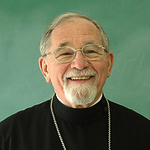The great Architect of the universe conceived and produced a being endowed with both natures, the visible and the invisible; God created the human being, bringing its body forth from the pre-exiting matter which he animated with his own Spirit ... Thus in some way a new universe was born, small and great at one and the same time. God set this ‘hybrid’ worshipper on earth to contemplate the visible world, and to be initiated into the invisible; to reign over earth’s creatures, and to obey orders from on high. He crated a being at one earthly and heavenly, insecure and immortal, visible and invisible, halfway between greatness and nothingness, flesh and spirit at the same time ... an animal en route to another native land, and, most mysterious of all, made to resemble God by simple submission to the divine will.
-- Gregory of Nazianzen, Oration 45, For Easter, 7 (PG 36, 850)
TALK ABOUT IT: What are the implications of being a ‘hybrid’ creature at the intersection of divine and human natures?
DO IT (INNER PRACTICE): Share your experience or attempts with “contemplating the visible world?”
DO IT (OUTER PRACTICE): Share your experience or attempts with “reigning over earth’s creatures”?
LEARNING FROM GREGORY OF NAZIANZEN: CHURCH OF RECONCILIATION
LEARNING FROM GREGORY OF NAZIANZEN: CHURCH OF RECONCILIATION



